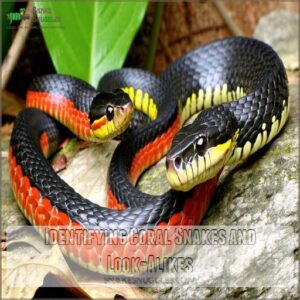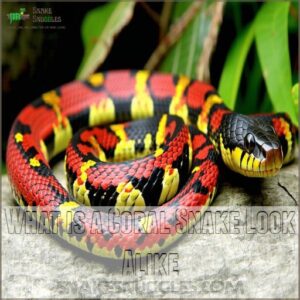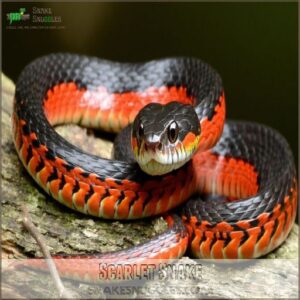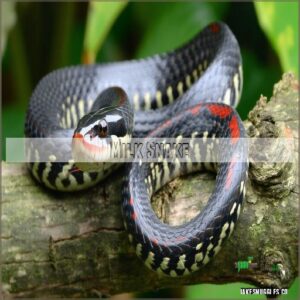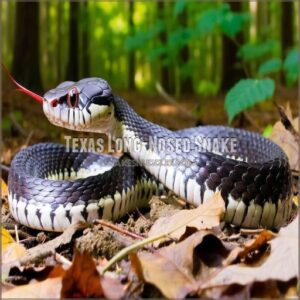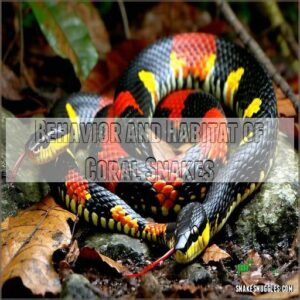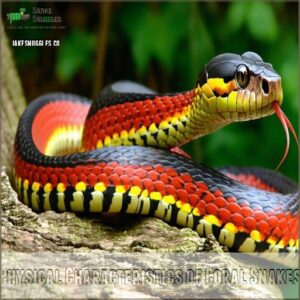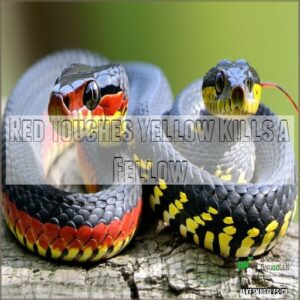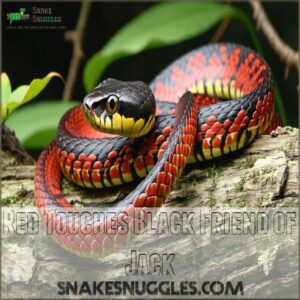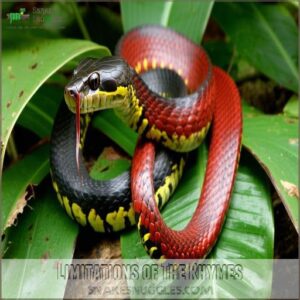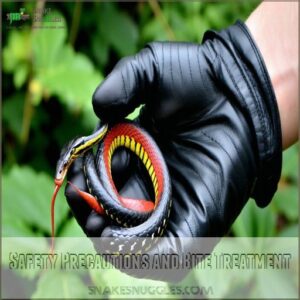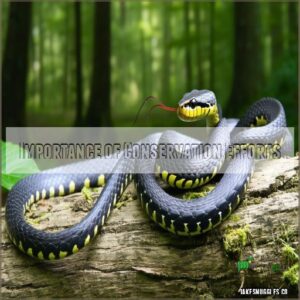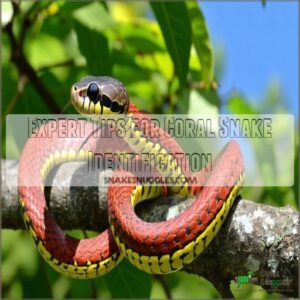This site is supported by our readers. We may earn a commission, at no cost to you, if you purchase through links.
 When you’re out and about, spotting a coral snake look-alike can be tricky yet fascinating.
When you’re out and about, spotting a coral snake look-alike can be tricky yet fascinating.
Coral snakes are venomous and sport red, yellow, and black bands.
Look-alikes, like the harmless scarlet kingsnake, mimic this pattern.
The rhyme "Red touches yellow, kills a fellow; red touches black, friend of Jack" helps distinguish them.
However, not all rhymes are foolproof, and exceptions exist.
In North America, you’ll meet look-alikes such as the Texas long-nosed snake and various milk snakes.
Understanding these similarities and differences can be critical.
Curious about these quirky mimics? Keep an eye out to stay safe and informed!
Table Of Contents
- Key Takeaways
- Identifying Coral Snakes and Look-Alikes
- What is a Coral Snake Look Alike
- Coral Snake Look-Alikes in North America
- Distinguishing Features of Coral Snakes
- Behavior and Habitat of Coral Snakes
- Physical Characteristics of Coral Snakes
- Rhymes and Rules for Coral Snakes
- Safety Precautions and Bite Treatment
- Importance of Conservation Efforts
- Expert Tips for Coral Snake Identification
- Frequently Asked Questions (FAQs)
- What is the difference between coral snakes and lookalikes?
- What snakes look like coral snakes?
- Do coral snakes look like king snakes?
- How can you tell a coral snake from a venomous snake?
- What is a coral snake?
- What is the difference between a coral snake and a false coral snake?
- Are There Any Non-venomous Snakes That Mimic Dangerous Ones?
- How Can I Tell the Difference Between a Rattlesnake and an Eastern Indigo Snake?
- How Can I Identify a Coral Snake From a Distance?
- Are There Any Specific Habitats Where Coral Snakes Can Be Found?
- What is the Most Effective Way to Tell the Difference Between a King Snake and a Coral Snake?
- What snake is mistaken for coral snake?
- What is the rhyme for coral snakes look alike?
- How do you tell if it’s a coral snake?
- What is the difference between a coral snake and a false coral snake?
- How to safely observe coral snake look-alikes?
- Are coral snake look-alikes also venomous?
- What environments attract coral snake mimics?
- Do coral snake mimics share similar diet habits?
- Can coral snake mimics interbreed with coral snakes?
- Conclusion
Key Takeaways
- You can distinguish coral snakes from their mimics using the rhyme "Red touches yellow, kills a fellow; red touches black, friend of Jack," but remember exceptions exist.
- Key differences include head color (coral snakes have black heads), belly color (coral snakes’ belly colors match their back), and band pattern variations.
- Common look-alikes include scarlet kingsnakes, milk snakes, and Texas long-nosed snakes; knowing their features helps you avoid misidentification.
- If bitten by a snake you suspect is venomous, seek immediate medical attention; don’t attempt to treat it yourself.
Identifying Coral Snakes and Look-Alikes
You’ll distinguish coral snakes by their bright red, black, and yellow bands encircling their bodies.
Don’t confuse them with non-venomous look-alikes.
Watch for key differences like head color and band arrangement to guarantee safe identification in the wild.
Key Characteristics of Coral Snakes
Picture encountering a coral snake—a vibrant warning in the wild. It’s got that classic red, yellow, and black band combo.
- Look for red and yellow rings that touch; "red touches yellow, kills a fellow."
- Notice its distinct black head.
- Coral snake venom isn’t just for show—it’s potent and demands respect for survival.
Common Features of Look-Alikes
Often, look-alikes like the Scarlet Kingsnake and Milk Snake create confusion.
They sport tricolored banding with similar patterns to coral snakes, a result of Batesian mimicry strategies.
However, look out for color variations and specific belly differences.
For instance, the Scarlet Snake’s white belly and the Graybanded Kingsnake’s distinct head markings set them apart.
Here’s a quick guide to differentiate:
| Snake Type | Belly Color | Head Markings | Band Pattern |
|---|---|---|---|
| Scarlet Kingsnake | White or red | Red head | Red meets black |
| Milk Snake | Patterned | Black markings | Red meets black |
| Scarlet Snake | White | Red head | Red meets black |
| Graybanded Kingsnake | Gray | Gray head | Distinct pattern |
What is a Coral Snake Look Alike
When you encounter a coral snake look-alike, you’re looking at non-venomous snakes that mimic coral snakes’ vibrant patterns to protect themselves from predators.
Accurate identification is essential since these mimics can be mistaken for the real thing, leading to unnecessary fear or harm.
Overview of Coral Snake Mimics
Coral snake mimics aren’t just pretty pretenders, they’re survival experts.
These crafty copycats share bright red, black, and yellow bands, fooling predators into thinking they’re venomous like coral snakes.
Key players include:
- Scarlet kingsnake: a classic impostor that can now be celebrated with scarlet kingsnake merchandise Scarlet Kingsnake Gifts.
- Milk snake: a larger, harmless mimic.
- Texas long-nosed snake: with a distinctive belly.
This mimicry is nature’s clever defense.
Importance of Accurate Identification
Identifying coral snake look-alikes isn’t just about curiosity; it’s about safety and awareness.
Milk snakes, with their banded patterns and vibrant colors, can be mistaken for coral snakes, but they are actually harmless. Misidentifying these venomous look-alikes could mean mistaking harmless snakes for threats.
Here’s a quick overview:
| Feature | Coral Snake | Mimic Snakes |
|---|---|---|
| Head Color | Black head | Red or White head |
| Belly Color | Band colors match back | Not matching |
| Behavior | Nocturnal, reclusive | Various habits |
Coral Snake Look-Alikes in North America
North America’s diverse ecosystem includes several non-venomous snakes that cleverly mimic the deadly coral snake.
You’ll learn to identify key differences between these look-alikes, such as the Scarlet Kingsnake, Scarlet Snake, Milk Snake, and Texas Long-nosed Snake, to protect your safety and appreciate the fascinating adaptations of these reptiles.
Scarlet Kingsnake
The Scarlet Kingsnake, a sly master of disguise, might make you double-take.
Its vibrant red, black, and yellow bands mimic the deadly coral snake, yet it’s all harmless show.
Found slithering through the southeastern U.S., this nonvenomous snake sticks to a diet of lizards, small rodents, and birds.
Remember, it’s "red touches black, friend of Jack.
Scarlet Snake
Moving from the Scarlet Kingsnake, imagine spotting a Scarlet Snake.
This non-venomous mimic boasts striking looks but isn’t deadly.
Its habitat spans eastern United States, often hiding near marshes or streams.
Note these specifics:
- Red bands with black outlines.
- White or light gray belly.
- Shy behavior, prefers underground.
- Diet includes small creatures.
- Fits well in its secretive, wet environment.
Milk Snake
Like the Scarlet Snake, the Milk Snake is another master of disguise.
Often mistaken for the venomous coral snake, this harmless mimic sports red, black, and white bands.
With a diet rich in rodents and a knack for thriving in diverse habitats, Milk Snakes are a popular choice for pet enthusiasts.
Remember, their head shape helps with their identification.
Texas Long-Nosed Snake
Let’s chat about the Texas Long-Nosed Snake, a nifty mimicry artist in the snake world.
Unlike the Milk Snake, this fellow sports red, black, and white bands, plus a distinct white belly.
Found across Texas and nearby regions, it thrives on a diet of lizards and amphibians.
Remember, despite its coral snake look, it’s non-venomous, highlighting nature’s clever disguises.
Distinguishing Features of Coral Snakes
When spotting a coral snake, focus on its distinctive pattern of red, yellow, and black bands, which often triggers a memorable rhyme.
Its black head with a short snout and matching belly color further distinguish it from less dangerous look-alikes.
Red, Yellow, and Black Bands
You’ve noticed those striking red, yellow, and black bands, right?
They’re the telltale signs of coral snakes, where the saying "red touches yellow" highlights their venomous nature.
But watch out, this mimicry pattern is shared by lookalikes like the scarlet kingsnake, where "red touches black" means "friend of Jack."
Identifying these band variations helps keep you safe.
Black Head and Short Snout
Notice the coral snake’s head; it’s black, unlike many mimics.
This, combined with its short snout, is another key identifying feature.
Remember to follow the coral snake identification guide’s tips, such as focusing on the distinctive color pattern where red touches yellow.
Remember these three things:
- A black head.
- A short snout.
- Complete bands around the body.
These details help you distinguish it from look-alikes like the Scarlet Kingsnake or Milk Snake, whose heads are different colors.
Belly Color Patterns
When it comes to identifying coral snakes, it’s all about the belly color patterns.
Coral snakes boast a consistent band pattern across their bodies, including their bellies.
While understanding the taxonomic relationship between milk snakes and kingsnakes can be useful for identification, milk snakes vs kingsnakes, In contrast, many mimics like the Scarlet Kingsnake and Milk Snake have lighter or wholly different belly colors.
This detail can be your key to safe snake identification and avoiding potential dangers.
Behavior and Habitat of Coral Snakes
You’ll find coral snakes mainly in forests and deserts, where they prefer underground habitats, often hidden under leaves or rocks.
These nocturnal creatures emerge to feed or bask in the sun, showing their brightly colored bands.
Nocturnal and Underground Behavior
Coral snakes, unlike the flashy scarlet king snakes, lead a quieter life underground.
Their nocturnal habits and burrowing behavior keep them concealed during the day, emerging only when hunger calls.
These venomous reptiles prefer staying hidden, hunting prey under cover of darkness.
To them, daylight is the enemy—no surprise they opt for privacy away from prying eyes and potential threats.
Forest and Desert Habitats
You might wonder where these elusive coral snakes call home.
They thrive in both forest ecosystems and desert landscapes, adapting beautifully to these habitats.
Their presence overlaps with various other species like the Scarlet Snake and the Milk Snake, adding to the stunning snake diversity.
Keep an eye out when exploring these areas, as habitat overlap is common.
Basking and Feeding Habits
Imagine you’re taking a leisurely stroll through the forest or desert.
Coral snakes, those stealthy, venomous creatures, bask in sunlight to regulate their temperature.
They’re picky eaters, savoring small reptiles or even smaller snakes.
Typically, these snakes are creatures of habit, feeding mostly at twilight.
Keep an eye out; a mistaken identity with a scarlet king snake might ruin your day!
Physical Characteristics of Coral Snakes
To identify a coral snake, you’ll notice they’re typically slender and range from 14 to 36 inches long.
They’ve a distinctive pattern of red, yellow, and black bands, with a black head that sets them apart from mimics.
Size and Length
Most coral snakes are relatively small, typically reaching lengths between 20 and 40 inches.
Their size is one way to distinguish them from larger mimics like milk snakes, which can grow much longer.
Scarlet kingsnakes and scarlet snakes are usually similar in size to coral snakes.
Keep in mind that a snake’s length can vary depending on its age and food availability.
Knowing the average size helps with identification, but always consider other distinguishing features.
Body Shape and Pattern
Why are coral snakes so fascinating?
Their body shape and banding patterns are key to identifying these elusive reptiles.
With striking red, yellow, and black rings, coral snakes boast a uniform body where bands wrap around completely, unlike milk snakes or scarlet kingsnakes.
These mimicry patterns are nature’s way of using color variations for survival.
Head Shape and Color
To identify coral snakes, focus on head shape and color.
The blunt snout of coral snakes also has smooth, glossy scales, a characteristic that distinguishes them from other snakes like the king snake with rougher scales. Learn more about snake scales and characteristics.
Coral snakes sport a distinctive black head with a short, rounded snout compared to their mimics, like the scarlet king snake, which has a red head.
Understanding the distinction between a copperhead’s triangular-shaped head and a non-venomous snake’s narrower head, as seen in snakes with similar patterns, is essential for snake identification to avoid mistaking a venomous snake for its harmless look-alikes.
Rhymes and Rules for Coral Snakes
When identifying coral snakes, you’ll often hear the rhyme "Red touches yellow, kills a fellow; red touches black, friend of Jack," which serves as a quick mnemonic to distinguish these venomous creatures from their non-venomous mimics.
While useful, remember this rhyme only applies accurately to North American coral snakes, highlighting the importance of understanding its limitations to make sure correct identification.
Red Touches Yellow Kills a Fellow
You’ve sized up coral snakes by their unique color patterns, knowing they possess a potent neurotoxin affecting nervous systems. but remember the rhyme, "Red touches yellow, kills a fellow." It boils down to:
- Red next to yellow: This signals danger; the snake’s venomous.
- Consistent pattern: Look for neat, complete rings.
- Color order: Helps in distinguishing coral snakes from harmless look-alikes.
Keep this handy for snake safety!
Red Touches Black Friend of Jack
So, the rhyme "red touches black, friend of Jack" safely points to non-venomous snakes, like king snakes and the scarlet snake.
This mnemonic helps you identify coral snake lookalikes in nature.
Mimics like the milk snake also follow this pattern, highlighting the contrast between venomous coral snakes and their harmless counterparts.
Keep this rhyme in mind for safer encounters.
Limitations of The Rhymes
While “red touches black, friend of Jack” offers a quick hint for distinguishing coral snakes, real-world exceptions can catch you off guard.
Geographic variations mean the rule doesn’t always stick outside North America.
Add snake diversity to the mix; non-coral snakes can still mimic these patterns.
Focus on head color and regional differences for more reliable snake identification.
Safety Precautions and Bite Treatment
Knowing how to avoid coral snakes and their mimics is essential for your safety; if bitten, immediately seek medical attention, as their venom causes serious neurological problems.
Avoiding Coral Snakes and Look-Alikes
Imagine you’re on a nature walk, and a tricolored snake slithers by.
How do you make sure it’s not a venomous coral snake?
Before heading out, consider preparing with a Coral snake safety kit.
Mimic identification is key.
Remember the rhyme, "Red touches yellow, kills a fellow," and don’t try snake handling yourself.
For snake safety tips, wear sturdy shoes and watch your step.
Many venomous look-alikes are harmless snakes, so know before you react.
Symptoms of Coral Snake Bites
Encountering coral snakes can be nerve-wracking, especially if bitten. Their venom is sneaky, often causing symptoms before pain sets in.
Watch for:
- Paralysis symptoms: Weakness or numbness creeping in
- Respiratory failure: Trouble catching your breath
- Neurological effects: Double vision or slurred speech
- Venomous bite: Nausea and fatigue
- Subtle onset: Non-painful bite initially
Recognizing these can help you get quicker help.
Treatment and First Aid for Bites
When a coral snake bites, act swiftly.
Call for help and stay calm.
Remove tight clothing around the bite.
Apply a pressure immobilization bandage, as it’s essential for coral snake bites, but avoid cutting or suctioning the bite.
Follow this quick reference:
| Step | Action |
|---|---|
| 1 | Call emergency services |
| 2 | Keep the bite area still |
| 3 | Apply a clean bandage |
Avoid cutting or suctioning the bite.
Trust medical pros for antivenom therapy.
Importance of Conservation Efforts
You play a critical role in conserving coral snake habitats, which helps maintain the balance of local ecosystems.
By staying informed and supporting conservation efforts, you can reduce human-snake conflicts and promote coexistence.
Protecting Coral Snake Habitats
Guarding coral snake habitats isn’t just about keeping these slithering wonders safe; it’s about balance in nature.
Here’s how you can help:
- Promote responsible tourism by staying on trails.
- Support conservation efforts that protect their habitats.
- Advocate against habitat loss through sustainable practices.
- Educate others on coral snake conservation to raise awareness.
Your actions can make a difference!
Reducing Human-Snake Conflicts
Conserving coral snake habitats isn’t just about space; it’s about creating a peaceful coexistence.
By snake-proofing your yard with barriers and keeping areas clear of debris, you reduce unwanted encounters.
Understanding snake behavior helps in crafting coexistence strategies.
Remember, venomous look-alikes and harmless snakes deserve respect.
With these snake safety tips, you can guarantee mutual protection and maintain habitat harmony.
Promoting Awareness and Education
Understanding snake mimicry is key to coral snake safety.
Learn to identify a harmless coral snake mimic, like the scarlet snake or milk snake, by understanding the distinct red, yellow, and black banding of venomous coral snakes, from a venomous coral snake.
Importantly, milk snakes, often mistaken for coral snakes due to their bright red, black, and white bands, are actually harmless non-venomous constrictors.
Wildlife education programs and snake awareness campaigns are essential.
Support conservation efforts to protect coral snake habitats.
Spread the word—your actions contribute to safer communities and a healthier ecosystem.
Let’s work together for better snake awareness!
Expert Tips for Coral Snake Identification
To confidently identify a coral snake, it helps to consult experts who can provide valuable insights into their distinct features.
Enhancing your observation skills by noting the specific band patterns and head colors can prevent potentially dangerous misidentifications.
Consulting Professionals and Experts
For snake identification, sometimes you’ve got to call in the pros.
Experts can offer important advice on telling venomous snakes apart from coral snake look-alikes, such as recognizing the distinctive pattern "red touches yellow" on a Coral Snake Identification, boosting your safety around local wildlife.
Consider using a snake identification app or consulting local wildlife experts before venturing into areas where these snakes reside.
Remember, expert advice can be a lifesaver.
Developing Observation Skills
Spotting a coral snake look alike requires sharp observation skills. Here’s how to up your game:
- Use Snake Identification Guides: Check out online resources like a detailed Snake Identification Tools to improve your skills. They’re your best friends in the field.
- Notice Visual Cues: Pay attention to color bands and head shape.
- Practice Pattern Recognition: Identify key color arrangements.
- Apply Critical Thinking: Assess characteristics like belly color and behavior.
Stay alert, and you’ll master snake identification!
Frequently Asked Questions (FAQs)
What is the difference between coral snakes and lookalikes?
Coral snakes are venomous and have red and yellow rings touching.
Harmless mimics, like kingsnakes, have red and black rings that connect.
Coral snakes have black heads, unlike mimics that often show red.
Remember, "Red touches yellow, dangerous fellow.
What snakes look like coral snakes?
Seriously, so many snakes mimic coral snakes!
Scarlet kingsnakes, milk snakes, and various kingsnakes are masters of disguise, sporting similar color patterns.
Don’t mess with them—they’re not always what they seem!
Do coral snakes look like king snakes?
Yes, coral snakes can resemble king snakes because both have red, black, and yellow or white bands.
However, coral snakes have red touching yellow bands, while king snakes have red touching black, which helps differentiate them.
How can you tell a coral snake from a venomous snake?
Spotting a coral snake involves checking the pattern: red and yellow bands touch, indicating it’s venomous.
Remember, "Red touches yellow, kills a fellow."
Unlike many venomous snakes, coral snakes have a rounded, non-triangular head.
What is a coral snake?
A coral snake is a highly venomous reptile with striking red, black, and yellow bands.
Its distinctive pattern helps identify it, but remember: "Red touches yellow, kills a fellow" applies only in North America.
What is the difference between a coral snake and a false coral snake?
Coral snakes and their mimics, like the false coral snake, differ in band patterns.
You’ll spot red bands touching yellow on venomous coral snakes, while non-venomous mimics show red touching black, indicating safety.
Are There Any Non-venomous Snakes That Mimic Dangerous Ones?
Some non-venomous snakes, like the scarlet kingsnake and milk snake, mimic the dangerous coral snake’s bright color patterns.
These mimicry acts deter predators, offering safety through the illusion of venomous defense without actual poison.
How Can I Tell the Difference Between a Rattlesnake and an Eastern Indigo Snake?
Rattlesnakes have rattles; eastern indigo snakes don’t. Rattlesnakes are thicker bodied and have triangular heads. Indigo snakes are slender with rounded heads. Easy peasy!
How Can I Identify a Coral Snake From a Distance?
Imagine this: red meets yellow bands—it’s trouble.
Spotting these bands touching along with a sleek black head from afar usually signals a coral snake.
Remember, "Red touch yellow, kill a fellow," for a safe distance.
Are There Any Specific Habitats Where Coral Snakes Can Be Found?
You’ll find coral snakes mainly in forested and desert regions.
They love hiding under tall grass, leaves, debris, or even rocks.
You might also spot them basking under the sun but mostly staying underground.
What is the Most Effective Way to Tell the Difference Between a King Snake and a Coral Snake?
About 80% of snakes in the U.S. are nonvenomous.
To tell coral snakes from king snakes, remember: "Red touches yellow, kills a fellow; red touches black, friend of Jack."
It’s all about the band colors touching.
What snake is mistaken for coral snake?
You might mistake a Scarlet kingsnake for a coral snake.
Both have red, black, and yellow bands, but remember, if red touches black, it’s a friend of Jack.
Red touches yellow, dangerous fellow.
What is the rhyme for coral snakes look alike?
When color warns like a garden of danger, use this rhyme: "Red touches yellow, kills a fellow; red touches black, friend of Jack."
It helps you separate venomous coral snakes from harmless mimic snakes in the wild.
How do you tell if it’s a coral snake?
Look for red and yellow bands touching.
Coral snakes have a black head, and their bands form complete circles around the body.
Use the rhyme: "Red touches yellow, kills a fellow; red touches black, friend of Jack.
What is the difference between a coral snake and a false coral snake?
Coral snakes boast a deadly venom; their mimics, however, are harmless. Spotting the difference? Real coral snakes have red touching yellow bands. Mimics? Red touching black bands. Simple, right?
How to safely observe coral snake look-alikes?
Think of coral snake look-alikes as the original pranksters of the snake world.
To safely observe them, use binoculars, stay alert for their unique band patterns, and remember: understanding their differences helps prevent unnecessary panic.
Are coral snake look-alikes also venomous?
Most coral snake look-alikes aren’t venomous.
These mimic snakes, like the Scarlet kingsnake and Milk snake, display similar color patterns but lack the dangerous venom.
Always exercise caution and verify identification in the wild.
What environments attract coral snake mimics?
Like nature’s art gallery, environments rich in leaf piles, tall grass, and logs attract coral snake mimics.
They prefer forests, wetlands, and deserts, using these natural covers for protection, hunting, and blending in seamlessly with their surroundings.
Do coral snake mimics share similar diet habits?
Coral snake mimics generally share similar dietary habits, feeding on lizards, small snakes, and amphibians.
They’re not venomous and rely on different hunting methods, like constriction.
This makes them less specialized in prey than coral snakes.
Can coral snake mimics interbreed with coral snakes?
Don’t panic; coral snake mimics can’t interbreed with coral snakes.
They belong to different species, making hybridization impossible.
Their mimicry is pure trickery for survival, not a romantic entanglement across snake species.
Relax, no snake hybrids!
Conclusion
Spotting the right snake: it’s important!
As you learn about coral snake look-alikes, remember that understanding these fascinating creatures is key to staying safe.
Identifying their unique features, like banding patterns and head colors, helps distinguish between venomous friends and harmless imitators.
With knowledge in hand, you’re better prepared to explore habitats while respecting these reptiles.
Stay curious, stay informed, and make sure each encounter with nature is both awe-inspiring and secure.

